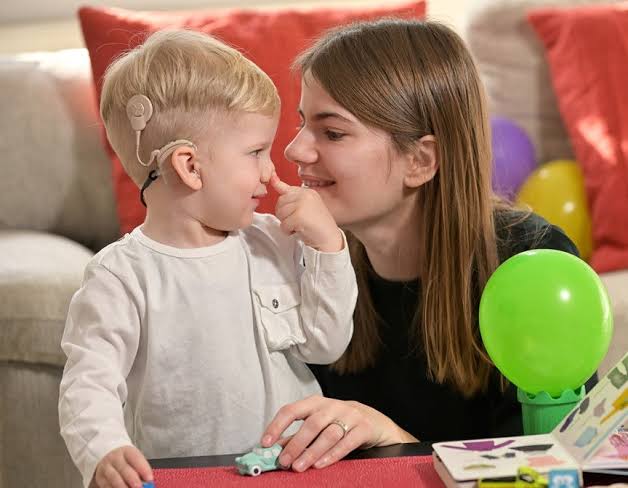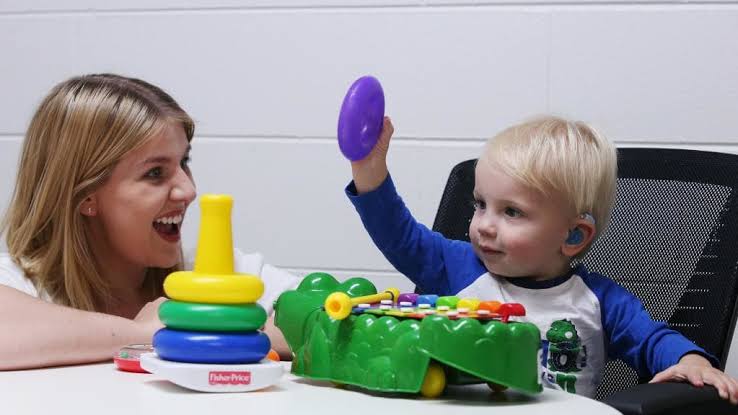
Auditory Verbal (AV) Therapy
Auditory Verbal (AV) therapy differs from speech therapy because it prioritises listening as a basis to both understanding and developing spoken communication. Some speech therapy for deaf children includes signing, gesture, pictures or lip-reading whereas Auditory Verbal therapy focuses on developing listening in order to learn spoken language.
Auditory Verbal Therapy (a.k.a. Auditory Oral Therapy) is very different from traditional Speech Therapy.
For starters, the focus is almost exclusively on children who are deaf and hard of hearing. Such students have difficulty receiving and processing incoming auditory information.
More specifically, children who receive Auditory Verbal Therapy have yet to master the ability to associate the sounds they receive (through their hearing aids or cochlear implants) with their corresponding meanings.
Auditory Verbal Therapy is designed to teach these children critical “listening skills.” And it accomplishes this by using age-appropriate exercises to help children acquire speech and language processing tools that commensurate with their hearing peers.
The ability to listen is crucial when developing a solid language foundation. In fact, the ultimate goal of Auditory Verbal Therapy is to help students mainstream into regular education settings so they can learn on par with the other students in their class.
Only by creating these sound/meaning associations can children graduate to the types of articulation exercises normally used in traditional Speech Therapy.
For example, children who are deaf and hard of hearing:
Must first learn how to detect incoming sounds – like a dog’s bark Then they learn how to discriminate between sounds (e.g. a “woof” vs. a “meow”)
Next, they need to identify the sound’s source by looking at the closest dog (instead of at a nearby cat) Finally, they learn how to comprehend the sound – i.e. barking = dog For those with normal hearing, all of the above happens organically.
But children who are deaf and hard of hearing often need guidance during this developmental process. Even with corrective hearing technology, auditory information has no intrinsic value until students learn to associate incoming signals with their underlying meanings.
Our Approach to Auditory Verbal Therapy
At the Upkar Speech therapy Hearing & clinic, we work with children who are deaf and hard of hearing. But unlike with most schools that cater to students with hearing difficulties
Can already “hear” the world around them thanks to assistive technologies like hearing aids and cochlear implants. Have the ability to learn to express themselves using spoken words. This explains why traditional Speech Therapy rarely features in our coursework. Our students just need help converting the incoming auditory signals relayed by their assistive hearing devices into information that makes sense.
Again – this happens automatically for children who grow up with normal hearing.
To bridge the gap and help our students make the right sound associations, we use a cognitive approach that differs from the typical vocabulary matching pedagogy that many speech therapists use.
For example, when asked to identify a circle drawn on the blackboard:

Students might be prompted to answer with the word “circle” in a standard Speech Therapy session. This is a very literal explanation of what the children see. But this rigid answer doesn’t capture the full nuance encoded in language.
Using Auditory Verbal Therapy, however, we encourage our students to explore a much broader range of answers to help them develop their linguistic abilities. The object on the blackboard may indeed be a circle. But it could just as easily be a sun, moon, face or any number of other possible answers.
This latter example is more in line with how auditory processing and spoken language both work in the human brain. Rarely is the relationship between incoming signals and their underlying meaning set in stone. By using Auditory Verbal Therapy, we help children who are deaf or harder hearing avoid strict 1:1 definitions as they develop a much deeper contextual understanding of language.

Does Auditory Verbal Therapy Work?
In the early stages, Auditory Verbal Therapy requires conscious and focused effort. Children must actively adopt a listening posture, which can be both taxing and frustrating.
But through carefully designed play-based lessons, Auditory Verbal Therapy helps to foster a listening attitude so that receiving and understanding incoming signals becomes as automatic as it is for those with normal hearing.
In fact, our students become excited about the learning process.
This is because Auditory Verbal Therapy helps to strip away many of the barriers that might otherwise prevent them from actively engaging. Sounds take on meaning, which allows our students to better understand the world and express themselves with much greater confidence.
And the results are measurable – given the frequency with which graduates of the Upkar speech therapy & hearing clinic mainstream into normal schools and thrive with their hearing peers.
Is Auditory Verbal Therapy Right for Your Child?
The best way to truly understand the value of Auditory Verbal Therapy is to watch the process in action. We invite you to do just that by visiting the UPKAR SPEECH THERAPY & HEARING CLINIC at any time during our normal academic year.